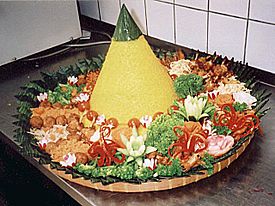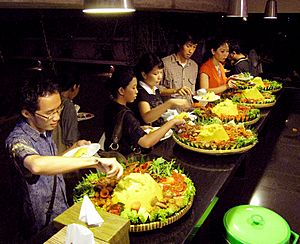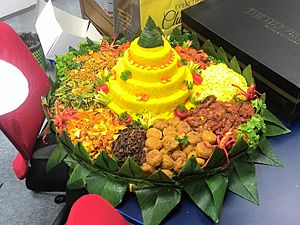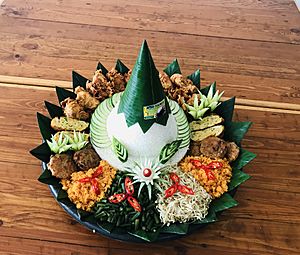Tumpeng facts for kids

Tumpeng: the cone shaped rice surrounded by assorted Indonesian dishes.
|
|
| Course | Main course |
|---|---|
| Place of origin | Indonesia |
| Region or state | Java, Nationwide |
| Associated national cuisine | Indonesia |
| Serving temperature | Hot or room temperature |
| Main ingredients | Cone shaped rice, urab (vegetables in shredded coconut), fried chicken, fried tempeh, boiled marble egg, shredded omelette, salted anchovy and peanuts |
| Variations | Tumpeng robyong, tumpeng putih, tumpeng nasi uduk, tumpeng slametan (nasi kuning) |
Tumpeng is a special cone-shaped rice dish from Indonesia. It comes with many different side dishes like vegetables and meat. This dish started in Javanese cuisine on the island of Java.
Traditionally, Tumpeng is part of a special ceremony called slamatan. The rice is cooked and shaped using a cone-shaped bamboo container. The rice can be plain steamed rice, uduk rice (cooked with coconut milk), or yellow rice (uduk rice colored with kunyit, which is turmeric).
The rice cone stands tall on a round woven bamboo tray called a tampah. This tray is covered with a banana leaf. Around the rice cone, you'll find many different Indonesian dishes. In 2014, the Indonesian government officially made Tumpeng the national dish. They said it "binds the diversity of Indonesian various culinary traditions."
Contents
History and meaning
People in Java, Bali, and Madura often make Tumpeng for important events. But many Indonesians know and love this dish. The idea behind Tumpeng is linked to Indonesia's geography, especially Java, which has many mountains and volcanos.
Long ago, people in Indonesia believed mountains were home to spirits of ancestors and gods. The cone shape of the Tumpeng rice represents these holy mountains. The meal was a way to say thank you for good harvests or other blessings.
A symbol of thanks
Tumpeng is a symbol of gratitude. In a thanksgiving ceremony, people pray. Then, the top part of the Tumpeng is cut off and given to the most important person. This could be a leader, the oldest person, or someone special. After that, everyone shares the Tumpeng together. It's a way to thank God and celebrate being together.
A yearly event with Tumpeng is often called 'tumpengan'. Huge amounts of Tumpeng are also part of the Javanese festival sekaten. They are paraded from the palace to the grand mosque. After prayers, they are shared with people to celebrate the birth of the prophet Mohammed.
Today, the top of the Tumpeng is often given to an honored guest at parties or award ceremonies. In cities like Yogyakarta, there's a tradition on the eve of August 17th, which is Indonesian Independence Day. People have a Tumpengan ceremony to pray for the nation's safety and well-being.
Dishes around the Tumpeng
The cone-shaped rice is surrounded by many different Indonesian dishes. These can include:
- urap (vegetables with shredded coconut)
- ayam goreng (fried chicken)
- ayam bakar (grilled chicken)
- empal gepuk (sweet and spicy fried beef)
- abon sapi (beef floss)
- semur (beef stew in sweet soy sauce)
- teri kacang (anchovy with peanuts)
- Fried prawn
- telur pindang (boiled marble egg)
- Shredded omelette
- tempe orek (sweet and dry fried tempeh)
- perkedel kentang (mashed potato fritters)
- perkedel jagung (corn fritters)
- sambal goreng ati (liver in chili sauce)
- Sliced cucumbers
And many other tasty things!
Traditionally, there should be a good mix of vegetables, egg, meat, and seafood. In Javanese culture, the dishes are chosen to balance each other. A traditional Javanese Tumpeng often has urap vegetables, tempeh, ayam goreng, teri kacang, fried shrimp, telur pindang, empal gepuk, and sambal.
Now that Tumpeng is a national dish, its side dishes can include popular Indonesian foods like gado-gado, satay, and rendang. The host can choose any dishes they like to go with the Tumpeng.
Meaning of the ingredients
Every part of a traditional Tumpeng has a special meaning. In Java and Bali, the cone shape represents life and nature. It also symbolizes God as the Creator. The side dishes and vegetables show the harmony of nature.
A complete Tumpeng should have:
- One type of meat (for land animals)
- Fish (for sea creatures)
- An egg (for winged animals)
- Vegetables (from plants)
Spinach is often included because it's a symbol of good fortune in Javanese farming communities.
Here are some meanings behind the ingredients:
- Egg: The egg is served with its shell on. Peeling it before eating shows that you need to plan and work hard to become a good person.
- Vegetables: A mix of vegetables means having good relationships with friends and neighbors.
- Spinach means a safe and peaceful life.
- Water spinach means you can get through tough times.
- String beans mean a long life.
- Mungbean sprouts mean carrying on your ancestors' legacy.
- Catfish: Catfish live at the bottom of ponds, so they represent being humble. They also remind us to be ready for future challenges.
- Milkfish: This fish has many bones, which symbolizes good luck and wealth in the future.
- Anchovies: Anchovies live together in groups. They represent having good relationships with family and neighbors.
Types of Tumpeng
There are different kinds of Tumpeng, used for various ceremonies:
- Tumpeng Robyong — Used in traditional Javanese siraman (bridal shower) ceremonies. It has egg, shrimp paste, shallots, and red chili on top.
- Tumpeng Nujuh Bulan — Served during the seventh month of pregnancy. It's made of plain white rice. One main Tumpeng is surrounded by six smaller ones.
- Tumpeng Pungkur — Used for the ceremony when a young, unmarried person passes away. It's white rice with only vegetable dishes. The Tumpeng is cut vertically into two equal parts and placed facing each other.
- Tumpeng Putih — White Tumpeng. White symbolizes holiness in Javanese culture, so this Tumpeng is used in sacred ceremonies.
- Tumpeng Nasi Kuning — Yellow Tumpeng. Yellow means gold, wealth, and good morals. This Tumpeng is used for happy celebrations like birthdays, engagements, weddings, Eid, or Christmas.
- Tumpeng Nasi Uduk — Also called tumpeng tasyakuran. It uses uduk rice (rice cooked in coconut milk). It's used for the Maulud Nabi ceremony, celebrating the birthday of prophet Muhammad.
- Mini Tumpeng — A small rice cone, usually for one person, like a rice box. It often comes in a clear container.
- Character Tumpeng Rice — This Tumpeng is shaped like different characters. Kids love it for birthdays, but it can also be a unique cone shape for celebrations.
Modern traditions

Today, many Indonesians serve Tumpeng to celebrate special moments. These include birthday parties, family gatherings, farewell parties, or other happy events. Because it's so festive, Tumpeng is sometimes seen as Indonesia's version of a birthday cake.
Sometimes, Tumpeng contests are held to celebrate Indonesian Independence Day (August 17th) or Women's Emancipation Day (April 21st). In these contests, Tumpengs are judged on how they look and how they taste.
In 2004, Indonesia's Ministry of Health even used a Tumpeng-based food pyramid to encourage healthy eating. This is because Tumpeng includes foods from every food group. The meat or soy dishes provide iron, zinc, and protein. The vegetable dishes give vitamins and minerals.
In 2009, Garuda Indonesia (an airline) started offering Mini Nasi Tumpeng Nusantara on its flights. This was part of a new idea to show Indonesia's hospitality. You can also find Tumpeng in Indonesian restaurants in other countries, like Singapore and the Netherlands.
The building of Suharto's Purna Bhakti Pertiwi Museum in Taman Mini Indonesia Indah, Jakarta, is even shaped like a Tumpeng!
See also
 In Spanish: Tumpeng para niños
In Spanish: Tumpeng para niños



